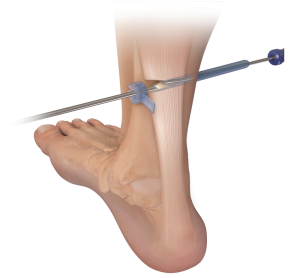
A gastrocnemius recession, also known as gastrocnemius lengthening or calf muscle release, is a surgical procedure in which the gastrocnemius muscle is partially cut to relieve tension and tightness in the calf. This procedure is typically performed to treat a condition called equinus deformity, which is characterized by limited ankle dorsiflexion (the ability to pull the foot upward toward the shin).
During the procedure, a small incision is made in the skin over the gastrocnemius muscle, and the muscle is partially cut or released from its attachment to the heel bone (calcaneus). This allows the muscle to stretch more easily and reduces tension on the Achilles tendon and plantar fascia.
Gastrocnemius recession is often performed in combination with other procedures, such as Achilles tendon lengthening or plantar fascia release, to address the underlying cause of equinus deformity. Recovery from the procedure typically involves a period of immobilization and physical therapy to regain strength and flexibility in the affected leg. As with any surgery, there are risks and potential complications associated with gastrocnemius recession, and it is important to discuss these with a qualified healthcare professional before undergoing the procedure.
